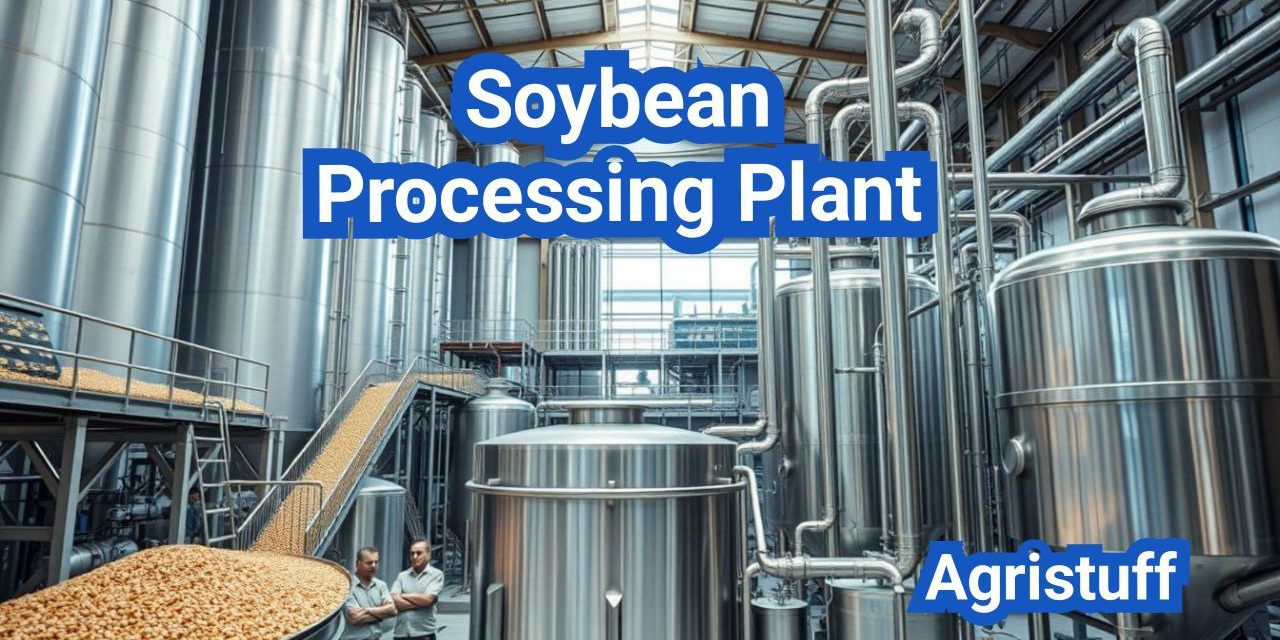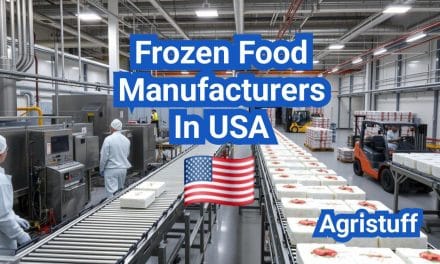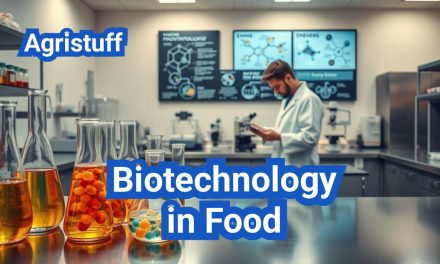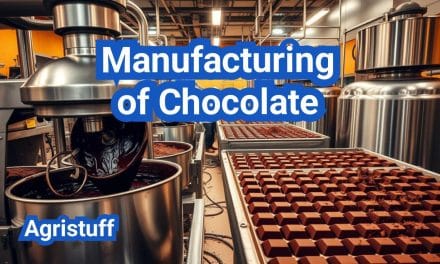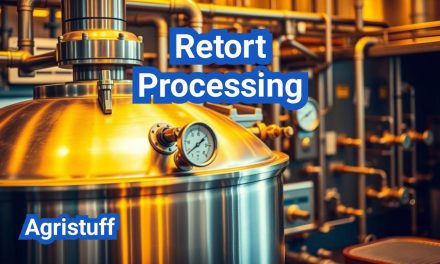The soybean processing industry plays a vital role in the global agricultural market, focusing on the extraction of oil and production of meal.
A soybean processing plant involves complex processes such as cleaning, cracking, and extraction to produce high-quality products.
The extracted oil is refined into various products, including edible oil and biodiesel, while soybean meal is used as a protein-rich feed supplement.
Understanding the intricacies of soybean processing is crucial for optimizing production and meeting the demands of the animal feed industry.
Key Takeaways
- Efficient soybean processing is critical for producing high-quality oil and meal.
- The soybean processing plant involves several complex steps, including cleaning and extraction.
- Soybean meal is a valuable by-product used in the animal feed industry.
- The industry plays a significant role in the global agricultural market.
- Optimizing soybean processing techniques is essential for meeting product demands.
Understanding the Soybean Processing Industry
The soybean processing industry in the United States is a vital component of the country’s agricultural economy, driven by key players and global demand. This industry is characterized by large-scale soybean processing plants operated by major companies such as Cargill, ADM, Bunge, and AG Processing Inc.
Current Market Trends in the US Soybean Sector
The US soybean sector is influenced by various market trends, including global demand fluctuations, trade policies, and weather conditions. According to recent market analyses, the demand for soybean products, particularly soybean oil and meal, has been on the rise due to increasing applications in food processing and animal feed industries.
Some of the key trends shaping the US soybean processing market include:
- Increasing demand for sustainable and environmentally friendly processing practices
- Advancements in processing technologies to improve efficiency and product quality
- Fluctuations in global soybean prices affecting profitability
- Growing export opportunities due to trade agreements
Major Players: Cargill, ADM, Bunge, and AG Processing Inc.
The US soybean processing industry is dominated by a few major players who operate large-scale processing facilities across the country. These companies are:
- Cargill: Known for its extensive global reach and diversified product portfolio
- ADM (Archer Daniels Midland): A leading player in the global soybean processing market with significant operations in the US
- Bunge: A global agribusiness company with a strong presence in soybean processing
- AG Processing Inc.: A cooperative-owned company specializing in soybean processing and other agricultural products
These companies have a significant impact on the industry, driving innovation, and setting market standards.
“The soybean processing industry is a critical component of the US agricultural economy, providing essential products for both domestic consumption and international trade.”
— Industry Expert
Economic Impact and Growth Opportunities
The soybean processing industry contributes substantially to the US economy through job creation, GDP generation, and tax revenues. The industry’s growth is influenced by factors such as global demand, technological advancements, and regulatory environments.
Some of the growth opportunities in the US soybean processing industry include:
| Opportunity | Description | Potential Impact |
|---|---|---|
| Expansion into new markets | Exploring emerging markets for soybean products | Increased revenue and market share |
| Technological innovation | Adopting advanced processing technologies | Improved efficiency and product quality |
| Sustainability initiatives | Implementing environmentally friendly practices | Enhanced brand reputation and compliance with regulations |
Establishing a Soybean Processing Plant Business

To establish a successful soybean processing plant, one must consider various factors including processing technology, equipment, and market trends. The complexity of the soybean processing industry demands a thorough understanding of the different types of processing facilities, the key components and equipment required, and the importance of capacity planning and scalability.
Types of Processing Facilities
Soybean processing plants can be categorized mainly into solvent extraction plants and mechanical extraction plants. Solvent extraction plants are the most common due to their high efficiency in extracting oil from soybeans. They use a solvent, typically hexane, to extract the oil. Mechanical extraction plants, on the other hand, use mechanical presses to extract oil, which is considered a more traditional method.
According to industry experts, “The choice between solvent extraction and mechanical extraction depends on the scale of operation and the desired products.” This highlights the importance of understanding the production goals and scale when deciding on the type of processing facility.
Key Components and Equipment Requirements
The key components of a soybean processing plant include extractors, desolventizers, and refining equipment. Efficient extraction equipment is crucial for maximizing oil yield and quality. Desolventizers are used to remove the solvent from the meal, and refining equipment is necessary for producing high-quality soybean oil.
- Extractors: Critical for oil extraction efficiency
- Desolventizers: Essential for removing solvent from soybean meal
- Refining Equipment: Necessary for producing refined soybean oil
Capacity Planning and Scalability Considerations
Capacity planning is vital to ensure that the processing plant can meet current and future demands. Scalability considerations are equally important to accommodate business growth. A well-planned capacity ensures operational efficiency and cost-effectiveness.
As noted by industry leaders, “Scalability is key to the long-term success of a soybean processing plant, allowing businesses to adapt to changing market conditions.” This emphasizes the need for flexible and scalable processing solutions.
| Capacity Planning Factors | Scalability Considerations |
|---|---|
| Market demand | Modular design |
| Raw material supply | Flexible equipment |
| Production costs | Future expansion plans |
Developing a Comprehensive Business Plan
Developing a comprehensive business plan is a critical step in establishing a soybean processing plant. This plan serves as a roadmap for the project, outlining key components necessary for success.
Market Analysis and Feasibility Study
A thorough market analysis is essential to understand the demand and supply dynamics of soybean products. This involves assessing the competitive landscape, identifying target markets, and determining the feasibility of the project.
A feasibility study will help in evaluating the practicality of the soybean processing plant. It includes analyzing the availability of raw materials, infrastructure requirements, and potential risks associated with the project.
Capital Investment Requirements
Estimating the capital investment required for setting up a soybean processing plant is crucial. This includes costs associated with land acquisition, equipment, construction, and initial working capital.
| Component | Cost (USD) |
|---|---|
| Land Acquisition | 500,000 |
| Equipment | 2,000,000 |
| Construction | 1,500,000 |
| Working Capital | 1,000,000 |
| Total | 5,000,000 |
Operational Cost Projections
Operational costs for a soybean processing plant include expenses such as raw materials, labor, utilities, and maintenance. Accurate operational cost projections are necessary to ensure the financial sustainability of the project.
- Raw Materials: $2 million annually
- Labor: $500,000 annually
- Utilities: $300,000 annually
- Maintenance: $200,000 annually
Return on Investment Calculations
Calculating the return on investment (ROI) is vital to assess the profitability of the soybean processing plant. This involves analyzing revenue projections against the total investment made.
By conducting a detailed ROI analysis, investors can make informed decisions about the viability of the project.
Site Selection and Plant Design

Site selection and plant design are crucial elements that determine the operational efficiency and environmental sustainability of a soybean processing plant. The process of selecting a site and designing the plant layout involves several critical factors that can significantly impact the overall success of the operation.
Strategic Location Factors
When evaluating potential sites for a soybean processing plant, several strategic location factors must be considered. These include:
- Proximity to soybean production areas to minimize transportation costs and ensure a steady supply of raw materials.
- Access to reliable transportation infrastructure, such as highways, railways, and ports, to facilitate the movement of goods.
- Adequate availability of utilities, including water, electricity, and natural gas, to support processing operations.
- Compliance with local zoning regulations and environmental permits to avoid legal and operational issues.
Plant Layout Optimization
Optimizing the plant layout is essential for efficient processing and minimizing operational costs. Key considerations include:
| Design Element | Description | Benefits |
|---|---|---|
| Process Flow | Designing the plant layout to facilitate a smooth and continuous process flow. | Reduces processing time, minimizes bottlenecks, and increases overall efficiency. |
| Equipment Placement | Strategically placing equipment to optimize space and reduce material handling costs. | Enhances productivity, reduces labor costs, and improves safety. |
| Safety Features | Incorporating safety features into the plant design to protect workers and equipment. | Reduces the risk of accidents, ensures compliance with safety regulations, and minimizes downtime. |
Environmental Impact Assessment
Conducting an environmental impact assessment is a critical step in the site selection and plant design process. This assessment helps identify potential environmental risks and develop strategies to mitigate them. Key areas of focus include:
The environmental impact assessment should evaluate the potential effects on air and water quality, soil contamination, and local ecosystems. By understanding these risks, plant designers can implement measures to minimize the plant’s environmental footprint.
Effective site selection and plant design are foundational to the success of a soybean processing plant. By carefully considering strategic location factors, optimizing the plant layout, and conducting thorough environmental impact assessments, operators can ensure efficient, sustainable, and compliant operations.
The Soybean Crushing Process Step-by-Step
The soybean crushing process is a multifaceted operation that involves several critical steps to produce high-quality soybean oil and meal. This process is fundamental to the soybean processing industry, as it directly impacts the quality and yield of the final products.
Preparation Phase
The preparation phase is the initial step in the soybean crushing process. It involves cleaning the soybeans to remove impurities and conditioning them to the appropriate moisture level for processing. This step is crucial as it ensures that the soybeans are in the optimal state for the subsequent processing steps.
Flaking Operations
After preparation, the soybeans are processed into flakes. This is done through a flaking mill, which rolls the soybeans into thin flakes. Flaking increases the surface area of the soybeans, making it easier to extract the oil in the later stages.
Cooking Processes
The soybean flakes then undergo a cooking process. Cooking the flakes helps to optimize oil extraction by breaking down the cellular structure of the soybeans, making the oil more accessible. The cooking process is carefully controlled to achieve the optimal temperature and moisture levels.
Process Flow Optimization
Optimizing the process flow is critical for efficient soybean crushing. This involves monitoring and adjusting the various stages of the process to ensure that they operate in harmony. Process flow optimization helps in achieving higher yields of soybean oil and meal, while also reducing energy consumption and operational costs.
By understanding and implementing these steps effectively, soybean processing plants can significantly enhance their productivity and the quality of their products.
Implementing Hexane Extraction Systems

The use of hexane extraction in soybean plants has revolutionized the oil production process, enhancing efficiency and yield. Hexane extraction is a solvent extraction process that involves using hexane to extract oil from soybeans.
Solvent Extraction Principles and Equipment
The solvent extraction process is based on the principle that hexane can effectively dissolve and extract oil from soybean flakes. The equipment used includes extraction vessels, solvent storage tanks, and oil/hexane separation units. The design and operation of this equipment are critical for optimizing oil extraction efficiency.
- Extraction vessels are designed to maximize contact between the solvent and soybean flakes.
- Solvent storage tanks are equipped with safety features to handle the flammable nature of hexane.
- Oil/hexane separation units use techniques like distillation to separate the oil from the solvent.
Setting Up Hexane Recovery Systems
A hexane recovery system is essential for minimizing solvent loss and ensuring environmental compliance. The setup involves designing an efficient condensation and recovery process to recycle hexane for reuse.
- The hexane/oil mixture is heated to vaporize the hexane.
- The vaporized hexane is then condensed and collected for reuse.
- Continuous monitoring is implemented to detect any hexane leaks or losses.
Safety Protocols for Solvent Handling
Handling hexane requires strict safety protocols due to its flammable and potentially hazardous nature. Safety measures include proper ventilation, explosion-proof equipment, and personal protective gear for workers.
- Regular training is provided to employees on hexane handling and emergency procedures.
- Fire suppression systems are installed in areas where hexane is used or stored.
Environmental Impact Management
Effective environmental impact management involves minimizing hexane emissions and ensuring proper disposal of hexane-containing waste. This is achieved through regular maintenance of equipment, monitoring of hexane levels, and implementation of best practices in solvent handling.
By understanding and implementing these aspects of hexane extraction systems, soybean processing plants can optimize their operations, improve safety, and reduce environmental impact.
Desolventizer Toaster (DT) Operation Guide
Effective operation of the desolventizer toaster (DT) is essential for removing solvents from soybean meal, ensuring the final product meets industry standards. The DT is a critical component in soybean processing plants, responsible for the desolventizing and toasting of soybean meal.
Equipment Selection and Installation
Selecting the right DT equipment is crucial for efficient operation. Factors to consider include capacity, material compatibility, and ease of maintenance. Proper installation is also vital, ensuring that the DT is integrated correctly with other processing equipment.
Key considerations for DT equipment selection include:
- Capacity to handle the required throughput
- Material construction that withstands corrosive environments
- Ease of cleaning and maintenance
Optimizing Process Parameters
Optimizing the DT process parameters is critical for achieving efficient solvent removal and producing high-quality soybean meal. Parameters to be controlled include temperature, pressure, and residence time.
Adjusting these parameters can significantly impact the final product quality. For instance, increasing the temperature can enhance solvent removal but may risk damaging the meal if not carefully controlled.
Meal Quality Monitoring
Continuous monitoring of the soybean meal quality is essential to ensure it meets the required standards. This involves checking for residual solvent levels, moisture content, and nutritional quality.
Quality control measures include:
- Regular sampling and analysis of the meal
- Adjusting DT process parameters based on analysis results
- Maintaining detailed records of quality control checks
Troubleshooting Common DT Issues
Despite careful operation, issues can arise with the DT. Common problems include inconsistent meal quality, equipment fouling, and solvent leakage.
Troubleshooting these issues requires a systematic approach, starting with identifying the root cause, whether it’s related to equipment, process parameters, or maintenance practices.
By following these guidelines and maintaining a proactive approach to DT operation, soybean processing plants can ensure the production of high-quality soybean meal while minimizing operational challenges.
Soybean Oil Refining Steps and Procedures

Soybean oil refining is a multi-step process crucial for producing high-quality edible oil. The refining process involves several key steps that work together to remove impurities, improve the oil’s color and texture, and enhance its overall quality.
Degumming Process
The degumming process is the first step in soybean oil refining. It involves the removal of impurities such as phospholipids, proteins, and other contaminants that can affect the oil’s quality and stability. Degumming is typically achieved through the addition of water or acid to the crude oil, causing the impurities to precipitate out and be removed.
Key aspects of degumming include:
- Hydration degumming using water
- Acid degumming using phosphoric or citric acid
- Enzymatic degumming using specific enzymes
Neutralization Techniques
Neutralization is a critical step that follows degumming. It involves the removal of free fatty acids (FFAs) from the oil through a process known as alkali neutralization. This step is essential for improving the oil’s flavor, odor, and color.
Neutralization techniques include:
- Alkali neutralization using sodium hydroxide
- Physical refining as an alternative for high FFA oils
Bleaching Operations
Bleaching is the process of removing color bodies and other impurities from the oil using bleaching earth or activated carbon. This step significantly improves the oil’s color and texture, making it more appealing to consumers.
Bleaching process considerations:
- Type and amount of bleaching earth used
- Temperature and contact time during bleaching
- Filtration techniques for removing spent bleaching earth
Deodorization Methods
Deodorization is the final step in the soybean oil refining process. It involves the removal of unwanted odors and flavors from the oil through a high-temperature vacuum distillation process. This step is crucial for producing a neutral-tasting oil that meets consumer expectations.
Deodorization techniques include:
- High-temperature vacuum distillation
- Steam injection for enhanced odor removal
In conclusion, soybean oil refining is a complex process that involves several critical steps: degumming, neutralization, bleaching, and deodorization. Each step plays a vital role in producing high-quality edible oil that meets consumer demands for taste, quality, and safety.
Producing 48% Protein Soybean Meal

Producing soybean meal with 48% protein involves several key steps, from desolventizing to quality control. This high-protein meal is a valuable commodity in the animal feed industry, serving as a critical source of nutrition for livestock.
Meal Processing After Desolventizing
After the desolventizing process, soybean meal undergoes further processing to enhance its quality and protein content. This involves grinding and sifting the meal to achieve the desired consistency and texture.
Grinding and Sifting: The meal is ground to a specific particle size to ensure uniformity. Sifting removes any lumps or oversized particles, resulting in a consistent product.
Protein Content Optimization
Optimizing the protein content of soybean meal to 48% requires careful control of the processing parameters. Factors such as temperature, moisture, and processing time are adjusted to achieve the desired protein level.
Process Adjustments: Adjusting the desolventizing temperature and the drying process can significantly impact the final protein content. Monitoring these parameters ensures that the meal meets the required specifications.
Quality Control Testing Protocols
Implementing rigorous quality control testing is crucial to ensure that the soybean meal meets the 48% protein standard. This involves regular sampling and analysis of the meal.
- Protein content analysis
- Moisture content testing
- Contaminant screening
Storage and Handling Best Practices
Proper storage and handling of soybean meal are essential to maintain its quality and nutritional value. This includes storing the meal in a dry, cool environment and protecting it from pests and contaminants.
Storage Conditions: The storage area should be well-ventilated and maintained at a consistent temperature. Regular inspections help prevent spoilage and ensure the meal remains suitable for use.
Extracting Lecithin from Soybean Oil

Soybean oil processing involves the extraction of lecithin, a phospholipid with diverse commercial uses. Lecithin is a valuable by-product of the soybean oil refining process, utilized in various industries due to its emulsifying properties.
Lecithin Separation Techniques
The separation of lecithin from soybean oil is typically achieved through a process known as degumming. Degumming involves the addition of water or acid to the crude soybean oil, causing the lecithin to hydrate and become insoluble, thus facilitating its separation.
Degumming Process: The degumming process is critical for the effective removal of lecithin. It involves mixing the crude oil with water or an acid, followed by centrifugation to separate the lecithin.
Drying and Standardization
After separation, the lecithin undergoes drying to remove any residual moisture. This step is crucial for preventing microbial growth and ensuring the stability of the lecithin. Standardization of lecithin involves adjusting its composition to meet specific commercial requirements.
The drying process typically involves the use of vacuum dryers or spray dryers to achieve the desired moisture level.
Quality Grading Systems
Quality grading of lecithin is based on its composition, including factors such as phospholipid content, moisture level, and the presence of impurities. Standard grading systems help in categorizing lecithin for different applications.
| Grade | Phospholipid Content (%) | Moisture Level (%) |
|---|---|---|
| Standard | 50-60 | <1 |
| Premium | 65-75 | <0.5 |
Commercial Applications and Markets
Lecithin derived from soybean oil has a wide range of applications, including in the food industry as an emulsifier, in pharmaceuticals, and in animal feed. The demand for lecithin is driven by its versatility and the growing need for natural emulsifiers.
The commercial applications of lecithin are diverse, with significant markets in North America, Europe, and Asia. Understanding these markets is crucial for producers to tailor their products to specific needs.
Utilizing Soybean Hulls and Fiber By-Products

Utilizing soybean hulls and fiber by-products effectively is crucial for maximizing revenue in soybean processing plants. Soybean hulls and fiber are valuable by-products that can be utilized in various applications, including animal feed, biofuel, and industrial products.
Hull Collection and Processing Systems
Efficient hull collection and processing systems are essential for handling the large quantities of hulls and fiber generated during soybean processing. These systems typically involve a combination of mechanical and pneumatic conveying equipment to transport the hulls from the processing area to storage or further processing facilities.
The design of these systems must consider factors such as capacity, energy efficiency, and dust control to minimize operational costs and environmental impact.
Value-Added Applications
Soybean hulls and fiber have a range of value-added applications that can significantly enhance their economic value. Some of the key applications include:
- Animal feed: Soybean hulls are used as a fiber source in animal feed, particularly for ruminants.
- Biofuel production: Soybean hulls can be used as a biomass fuel source for energy production.
- Industrial products: Soybean hulls are used in the production of various industrial products, such as particleboard and other composite materials.
Maximizing By-Product Revenue Streams
To maximize revenue from soybean hulls and fiber, processing plants must adopt strategies that enhance the value of these by-products. This can involve improving the quality and consistency of the hulls and fiber, developing new applications, and establishing strong market links.
By focusing on these areas, soybean processing plants can turn what was once considered waste into significant revenue streams, enhancing the overall profitability and sustainability of their operations.
Regulatory Compliance Framework

Ensuring regulatory compliance is a top priority for soybean processing facilities. The industry is subject to a complex set of regulations that govern various aspects of production, from edible oil extraction to animal feed manufacturing.
Implementing FSMA21 CFR117 for Edible Oil Production
The Food Safety Modernization Act (FSMA) has introduced stringent regulations for edible oil production, encapsulated in 21 CFR 117. This regulation mandates that soybean processing facilities implement Good Manufacturing Practices (GMPs) and Hazard Analysis and Risk-Based Preventive Controls. Compliance involves:
- Conducting a thorough hazard analysis
- Implementing preventive controls
- Establishing a recall plan
- Providing training for personnel
FSMA21 CFR507 Compliance for Animal Feed Products
For facilities producing animal feed from soybean by-products, compliance with 21 CFR 507 is crucial. This regulation focuses on the safe production and distribution of animal feed, requiring:
- Implementation of GMPs specific to animal feed
- Conducting a hazard analysis for animal feed
- Establishing preventive controls for identified hazards
- Maintaining detailed records of production and distribution
Environmental Permits and Monitoring
Soybean processing facilities must also comply with environmental regulations, obtaining necessary permits and implementing monitoring systems. This includes:
- Air quality permits
- Water discharge permits
- Waste management plans
- Regular monitoring and reporting
Quality Certification Programs
To enhance product quality and marketability, many soybean processing facilities participate in quality certification programs. These programs, such as ISO 9001 for quality management, help facilities demonstrate their commitment to quality and regulatory compliance.
By adhering to these regulatory requirements and certification programs, soybean processing facilities can ensure the production of high-quality products while minimizing environmental impact and maintaining compliance with industry standards.
Technological Innovations in Modern Processing Plants

Technological advancements are transforming the soybean processing landscape, with a focus on automation, process control, and sustainable practices. Modern soybean processing plants are increasingly adopting innovative technologies to enhance efficiency, reduce operational costs, and minimize environmental impact.
Automation and Process Control Systems
The integration of automation and advanced process control systems is revolutionizing soybean processing. These technologies enable real-time monitoring and control of processing parameters, ensuring optimal performance and consistency in product quality. Automation not only improves efficiency but also reduces the risk of human error, leading to safer and more reliable operations.
Advanced process control systems utilize sophisticated algorithms and data analytics to optimize processing conditions. This includes precise control over temperature, pressure, and flow rates, which are critical in various stages of soybean processing, from extraction to refining.
Energy Efficiency Optimization
Energy efficiency is a critical aspect of modern soybean processing plants. Technological innovations in this area focus on reducing energy consumption while maintaining or improving production capacity. Heat recovery systems and energy-efficient equipment are being implemented to minimize energy waste and lower operational costs.
Moreover, the adoption of renewable energy sources, such as biomass and solar power, is becoming increasingly prevalent. These sustainable energy solutions not only reduce the carbon footprint of soybean processing but also contribute to long-term cost savings.
Sustainable Processing Technologies
Sustainability is a key driver in the adoption of new technologies in soybean processing. Innovative processing technologies aim to minimize environmental impact by reducing water consumption, waste generation, and emissions. For instance, water recycling systems and waste-to-value strategies are being implemented to enhance sustainability.
Additionally, the development of more efficient extraction methods and the use of environmentally friendly solvents are areas of ongoing research and development. These advancements are crucial for reducing the ecological footprint of soybean processing operations.
Future Trends in Soybean Processing
Looking ahead, the soybean processing industry is expected to continue its technological evolution. Emerging trends include the adoption of artificial intelligence (AI) and machine learning (ML) for predictive maintenance and process optimization. These technologies have the potential to further enhance efficiency, reduce costs, and improve product quality.
Furthermore, the integration of Internet of Things (IoT) devices will enable more comprehensive monitoring and control of processing operations, facilitating data-driven decision-making and driving innovation in the industry.
At The End of: Soybean Processing Plant
The soybean processing industry is a significant sector in the global agricultural market, playing a crucial role in the production of various products, including soybean oil, meal, and other by-products. As the demand for these products continues to grow, understanding the intricacies of soybean processing is essential for optimizing production and ensuring the long-term viability of the industry.
A soybean processing plant is a complex facility that requires careful planning, design, and operation. By leveraging technological innovations, implementing efficient processing systems, and adhering to regulatory requirements, soybean processing plants can achieve high-quality products while minimizing environmental impact.
As the industry continues to evolve, it is crucial for stakeholders to stay informed about market trends, technological advancements, and best practices in soybean processing. By doing so, they can capitalize on growth opportunities and contribute to the sustainability of the soybean processing industry.
FAQ
What is the primary function of a soybean processing plant?
The primary function of a soybean processing plant is to extract oil and produce soybean meal, which is used as a protein-rich feed supplement in the animal feed industry.
What are the major players in the US soybean processing industry?
The major players in the US soybean processing industry are Cargill, ADM, Bunge, and AG Processing Inc.
What are the key components and equipment required for a soybean processing plant?
The key components and equipment required for a soybean processing plant include extractors, desolventizers, refining equipment, and other machinery necessary for cleaning, cracking, dehulling, and extraction.
What is the significance of hexane extraction in soybean processing?
Hexane extraction is a solvent extraction process that involves using hexane to extract oil from soybeans, and it is a critical step in the production of high-quality soybean oil.
How is soybean meal processed to achieve 48% protein content?
Soybean meal is processed to achieve 48% protein content through careful processing and quality control, including meal processing after desolventizing, protein content optimization, and quality control testing protocols.
What are the regulatory requirements for soybean processing plants in the US?
Soybean processing plants in the US must comply with FSMA21 CFR117 for edible oil production and FSMA21 CFR507 for animal feed products, as well as obtain environmental permits and monitoring, and participate in quality certification programs.
What are the benefits of utilizing soybean hulls and fiber by-products?
Soybean hulls and fiber by-products can be utilized in various applications, including animal feed, biofuel, and industrial products, providing additional revenue streams for soybean processing plants.
How is lecithin extracted from soybean oil?
Lecithin is extracted from soybean oil through lecithin separation techniques, drying and standardization, and quality grading systems, resulting in a valuable by-product with various commercial applications.
What are the current market trends in the US soybean sector?
The current market trends in the US soybean sector are influenced by factors like global demand, trade policies, and weather conditions, and understanding these trends is crucial for stakeholders to make informed decisions.
What are the technological innovations in modern soybean processing plants?
Modern soybean processing plants are adopting technological innovations, including automation and process control systems, energy efficiency optimization, and sustainable processing technologies, to improve efficiency and reduce environmental impact.
What is the significance of desolventizer toaster (DT) operation in soybean processing?
The desolventizer toaster (DT) operation is critical in soybean processing, as it is responsible for removing the solvent from the meal, and optimizing process parameters, monitoring meal quality, and troubleshooting common issues are essential for ensuring the production of high-quality soybean meal.
How is soybean oil refined to produce high-quality edible oil?
Soybean oil is refined through a series of steps, including degumming, neutralization, bleaching, and deodorization, to produce high-quality edible oil.
Conclusion of: Soybean Processing Plant In USA
Introduction: Why a Soybean Processing Plant Matters
A soybean processing plant turns U.S.-grown beans into two cornerstone commodities—edible oil and high-protein meal—through a standardized flow that includes receiving, preparation, solvent extraction, and oil refining, all under strict safety and quality controls. Understanding this flow inside a soybean processing plant helps manufacturers plan capacity, assure compliance, and compete on consistent yields and product quality. Soybean facts and yields (NOPA)
U.S. Crush Context and the Commercial Ecosystem
No soybean processing plant operates in a vacuum; it lives in a national “crush” ecosystem where processors monitor throughput, meal and oil supplies, and price signals. Monthly crush data guide scheduling, inventories, and risk management, and inform long-term decisions about debottlenecking or adding capacity at each soybean processing plant. National Oilseed Processors Association (NOPA)
Receiving, Sampling, and Grading at the Gate
A soybean processing plant receives truck or rail loads and samples each lot to check moisture, foreign material, splits, and damage before staging for storage or immediate run. U.S. grading standards and certificates bring uniformity to beans entering a soybean processing plant, helping reduce disputes and maintain quality baselines for extraction yield and meal specs. USDA AMS: Soybeans—Grades & Standards
Storage and Moisture: Protecting Oil and Protein
Moisture and temperature management upstream of a soybean processing plant protect oil quality and protein yield by curbing mold, respiration losses, and free-fatty-acid formation. Extension guidance emphasizes sufficiently dry beans and good aeration so the soybean processing plant receives sound grain that extracts efficiently and refines cleanly. NDSU Extension: Drying & Storing Soybeans
Cleaning and Preparation: Remove What Doesn’t Crush
Inside a soybean processing plant, screens, aspirators, and magnets remove fines, dust, and tramp metal before cracking. This cleaning stage cuts wear on downstream machinery, limits hazards, and improves solvent economy—practical steps that every soybean processing plant uses to maintain reliability and product purity. EPA AP-42 §9.11.1: Vegetable Oil Processing
Cracking and Dehulling: Exposing the Cotyledon
After cleaning, a soybean processing plant cracks the beans to expose “meats,” then removes hulls by aspiration and sifting. Dehulling lifts the protein of the finished meal and improves extractor performance, making it a standard practice in any modern soybean processing plant. EPA AP-42: Preparation & Dehulling Overview
Conditioning and Flaking: Ready for Solvent
To maximize yield, a soybean processing plant conditions cracked meats to the right temperature and moisture, then flakes them to create thin, permeable layers. Proper flake integrity exposes intracellular oil but still allows solvent percolation, which is a core economics lever in any soybean processing plant. EPA AP-42: Conditioning & Flaking
Solvent Extraction: Counter-Current Micella “Wash”
The extractor is the heart of the soybean processing plant, where counter-current solvent (commonly hexane) “washes” oil from flakes to form micella. After multiple stages, residual oil in defatted flakes drops dramatically, and the solvent is condensed and recovered—key for the solvent balance sheet at a soybean processing plant. AOCS Lipid Library: Solvent Extraction
Desolventizer-Toaster and Meal Finishing
Post-extraction, the soybean processing plant uses a desolventizer-toaster (DT), dryer, and cooler to remove residual solvent and to toast antinutritional factors, stabilizing protein. This creates stable flakes that are ground and cooled into meal, the primary tonnage leaving a soybean processing plant. FAO: Solvent Extraction—Meal Desolventizing & Toasting
Meal Grades and Value in Feed Rations
A typical soybean processing plant supplies 48% protein soybean meal for poultry and swine diets, prized for amino acid balance and consistent energy. Formulators depend on predictable quality out of a soybean processing plant to hit growth targets while controlling feed costs. Feedipedia: Soybean Meal
Why Nutritionists Like U.S. Soybean Meal
Nutritionists credit the soybean processing plant flow (proper toasting and moisture control) for high digestibility of essential amino acids in soybean meal. That consistency lets buyers lock in performance expectations from a soybean processing plant across regions and seasons. Feedipedia: Nutritional Profile & Digestibility
Crude Oil Handling and Degumming: First Purification Step
On the oil side, a soybean processing plant starts with degumming: hydrating and removing phospholipids to protect equipment and product quality. Effective degumming is foundational whether the soybean processing plant uses chemical or physical refining downstream. AOCS Lipid Library: Degumming
Neutralization, Bleaching, and Winterization
After degumming, a soybean processing plant neutralizes free fatty acids (chemical refining) and uses bleaching earth/silica to remove color bodies and pro-oxidants, with optional winterization for salad oils. These steps set up stable, low-color oil for final finishing in the soybean processing plant. AOCS Lipid Library: Chemical Refining & Bleaching
Deodorization and the Path to Physical Refining
Deodorization in a soybean processing plant uses steam stripping under high vacuum to remove odor- and flavor-active volatiles; in physical refining, this step also removes FFAs. Very low phosphorus after degumming is critical if a soybean processing plant targets physical refining. AOCS Lipid Library: Deodorization
Lecithin Recovery: A Valuable Gum By-Product
Degumming at a soybean processing plant yields lecithin—a marketable emulsifier for foods and pharma—after drying and standardization. In the U.S., lecithin is affirmed as GRAS, giving soybean processing plant operators a compliant path to valorize this by-product. eCFR: 21 CFR §184.1400 Lecithin
Other By-Products: Hulls, Soapstock, and Distillates
Beyond meal and refined oil, a soybean processing plant monetizes hulls (fiber), soapstock from neutralization (which can be split/acidulated), and deodorizer distillate rich in tocopherols and sterols. Managing these streams boosts sustainability and the bottom line at a soybean processing plant. AOCS Lipid Library: Processing & By-Products
Emissions and Solvent Stewardship
Because extraction uses volatile solvent, a soybean processing plant must control emissions and maintain tight recovery systems. AP-42 documentation details sources and controls that engineers use when designing or expanding a soybean processing plant. EPA AP-42 §9.11.1: Emissions & Controls
Food Safety Programs for Edible Oil
Edible-oil lines in a soybean processing plant fall under the Preventive Controls for Human Food rule, requiring a written hazard analysis, preventive controls, monitoring, verification, and recall planning. Robust programs reduce risk and strengthen brand trust from a soybean processing plant. eCFR: 21 CFR Part 117 (Human Food)
Feed Safety Programs for Meal and Co-Products
Animal-food lines in a soybean processing plant must comply with the Preventive Controls for Animal Food rule, which mandates CGMPs, hazard analyses, and risk-based preventive controls. Buyers expect this assurance from a compliant soybean processing plant. eCFR: 21 CFR Part 507 (Animal Food)
Yields and Mass Balance: What One Bushel Becomes
A soybean processing plant manages mass balance between oil and meal; typical U.S. beans produce substantial meal tonnage and a significant oil fraction. These fundamentals determine revenue split, solvent economy, and production planning in every soybean processing plant. NOPA: Typical Soybean Bushel Products
Reliability, Safety, and Process Control
From magnets and screens at receiving to vacuum and heat at deodorization, a soybean processing plant relies on operator training, condition-based maintenance, and strict solvent handling. Safety programs for hexane and other utilities are non-negotiable in any soybean processing plant. OSHA: n-Hexane Safety
Market Uses of Oil and Meal in the U.S.
A soybean processing plant sells refined oil into food, biodiesel, and chemical markets, while meal anchors poultry and swine rations. Market diversification helps a soybean processing plant weather commodity cycles and support stable employment in rural communities. USDA ERS: Soybeans & Oil Crops
Environmental and Energy Considerations
Energy efficiency in a soybean processing plant hinges on heat integration (desolventizer vapors, deodorizer sparge steam recovery) and vigilant solvent recirculation. Well-tuned utilities reduce operating costs and emissions while maintaining throughput at the soybean processing plant. EPA: Vegetable Oil Processing—Energy & Emissions
Capital Planning and Scale-Up
Planning a new or expanded soybean processing plant means optimizing elevator capacity, preparation train sizing, extractor area, DT/DC residence times, and refining throughput. A balanced front-to-back design ensures the soybean processing plant achieves target yields without bottlenecks. AOCS Lipid Library: Processing Overview
Quality Control and Lab Testing
The QA/QC lab in a soybean processing plant verifies moisture, oil content, phosphorous, free fatty acids, color, peroxide value, and sensory attributes, guiding real-time adjustments. Strong QC underpins customer trust and repeat contracts with a soybean processing plant. AOCS: Analytical & Quality Resources
Final Thought
Whether you’re scoping a greenfield build or upgrading an existing soybean processing plant, success comes from disciplined seed handling, efficient solvent extraction and recovery, and world-class refining backed by robust food/feed safety plans. Nail those pillars and your soybean processing plant will deliver consistent oil, high-value meal, and monetized by-products year-round. USDA ERS: Market & Industry Context
Sources & References
The following authoritative sources underpin the engineering, safety, and regulatory concepts described for a soybean processing plant:
- NOPA — Industry association
- AOCS Lipid Library — Solvent Extraction
- FAO — Solvent extraction: meal desolventizing & toasting
- Feedipedia — Soybean Meal: composition & uses
- AOCS Lipid Library — Deodorization
- eCFR — 21 CFR §184.1400 Lecithin
- eCFR — 21 CFR Part 117 (Human Food)
- eCFR — 21 CFR Part 507 (Animal Food)
- USDA ERS — Soybeans & Oil Crops

